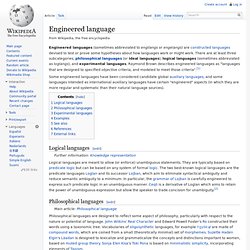

Constructed languages 1902-1999. Alphabet of human thought. The alphabet of human thought is a concept originally proposed by Gottfried Leibniz that provides a universal way to represent and analyze ideas and relationships, no matter how complicated, by breaking down their component pieces.

All ideas are compounded from a very small number of simple ideas which can be represented by a unique "real" character.[1][2] René Descartes suggested that the lexicon of a universal language should consist of primitive elements. The systematic combination of these elements, according to syntactical rules, would generate "an infinity of different words". In the early 18th century, Leibniz outlined his characteristica universalis, an artificial language in which grammatical and logical structure would coincide, which would allow much reasoning to be reduced to calculation.
Leibniz acknowledged the work of Ramon Llull, particularly the Ars generalis ultima (1305), as one of the inspirations for this idea. Engineered language. Engineered languages (sometimes abbreviated to engilangs or engelangs) are constructed languages devised to test or prove some hypotheses about how languages work or might work.

There are at least three subcategories, philosophical languages (or ideal languages), logical languages (sometimes abbreviated as loglangs), and experimental languages. Raymond Brown describes engineered languages as "languages that are designed to specified objective criteria, and modeled to meet those criteria".[1] Some engineered languages have been considered candidate global auxiliary languages, and some languages intended as international auxiliary languages have certain "engineered" aspects (in which they are more regular and systematic than their natural language sources). Natural semantic metalanguage. The Natural semantic metalanguage (NSM) is a linguistic theory based on the conception of Polish professor Andrzej Bogusławski. The leading proponents of the theory are Anna Wierzbicka at Warsaw University and later at the Australian National University who originated the theory in the early 1970s (Wierzbicka 1972), and Cliff Goddard at Australia's Griffith University (Goddard & Wierzbicka 1994, 2002).
Approach[edit] Linguists of the NSM school rely on semantic primitives (or semantic primes) for analysis (that is, simple, indefinable, and universally lexicalized concepts) and reductive paraphrase (that is, breaking complex concepts down into simpler concepts). Research in the NSM approach deals extensively with language and cognition, and language and culture. Key areas of research include lexical semantics, grammatical semantics, phraseology and pragmatics, as well as cross-cultural communication. Semantic primitives[edit] The English exponents of semantic primitives[3] substantives speech. Morpheme. Classification of morphemes[edit] Free vs. bound[edit] Every morpheme can be classified as either free or bound.[3] These categories are mutually exclusive, and as such, a given morpheme will belong to exactly one of them.
Bound morphemes can be further classified as derivational or inflectional. Philosophical language. An Essay towards a Real Character and a Philosophical Language. An Essay towards a Real Character, and a Philosophical Language (London, 1668) is the best-remembered of the numerous works of John Wilkins, in which he expounds a new universal language, meant primarily to facilitate international communication among scholars, but envisioned for use by diplomats, travelers, and merchants as well.

Unlike many universal language schemes of the period, it was meant merely as an auxiliary to — not a replacement of — existing "natural" languages. The first edition cover page Background[edit] There was immediate interest in the Essay; Wilkins is said to have regarded his work only in terms of a proof of concept.[6] But in the medium term enthusiasm for this kind of constructed language declined. Blissymbols. Blissymbols or Blissymbolics was conceived as an ideographic writing system called Semantography consisting of several hundred basic symbols, each representing a concept, which can be composed together to generate new symbols that represent new concepts.

Blissymbols differ from most of the world's major writing systems in that the characters do not correspond at all to the sounds of any spoken language. History[edit] Blissymbols was invented by Charles K. Bliss (1897–1985), born Karl Kasiel Blitz in the Austro-Hungarian city of Czernowitz (at present the Ukrainian city of Chernivtsi), which had a mixture of different nationalities that “hated each other, mainly because they spoke and thought in different languages.”[1] Bliss graduated as a chemical engineer at the Vienna University of Technology, and joined an electronics company as a research chemist.
As the German Army invaded Austria in 1938, he was sent to the concentration camps of Dachau and Buchenwald. The speech question[edit] Calculus ratiocinator. The Calculus Ratiocinator is a theoretical universal logical calculation framework, a concept described in the writings of Gottfried Leibniz, usually paired with his more frequently mentioned characteristica universalis, a universal conceptual language.

Two views[edit] There are two contrasting points of view on what Leibniz meant by calculus ratiocinator. The first is associated with computer software, the second is associated with computer hardware. The analytic view[edit] The received point of view in analytic philosophy and formal logic, is that the calculus ratiocinator anticipates mathematical logic — an "algebra of logic".[1] The analytic point of view understands that the calculus ratiocinator is a formal inference engine or computer program which can be designed so as to grant primacy to calculations. The synthetic view[edit] A contrasting point of view stems from synthetic philosophy and fields such as cybernetics, electronic engineering and general systems theory. Characteristica universalis. The Latin term characteristica universalis, commonly interpreted as universal characteristic, or universal character in English, is a universal and formal language imagined by the German philosopher Gottfried Leibniz able to express mathematical, scientific, and metaphysical concepts.

Leibniz thus hoped to create a language usable within the framework of a universal logical calculation or calculus ratiocinator. The characteristica universalis is a recurring concept in the writings of Gottfried Leibniz. When writing in French, he sometimes employed the phrase spécieuse générale to the same effect.